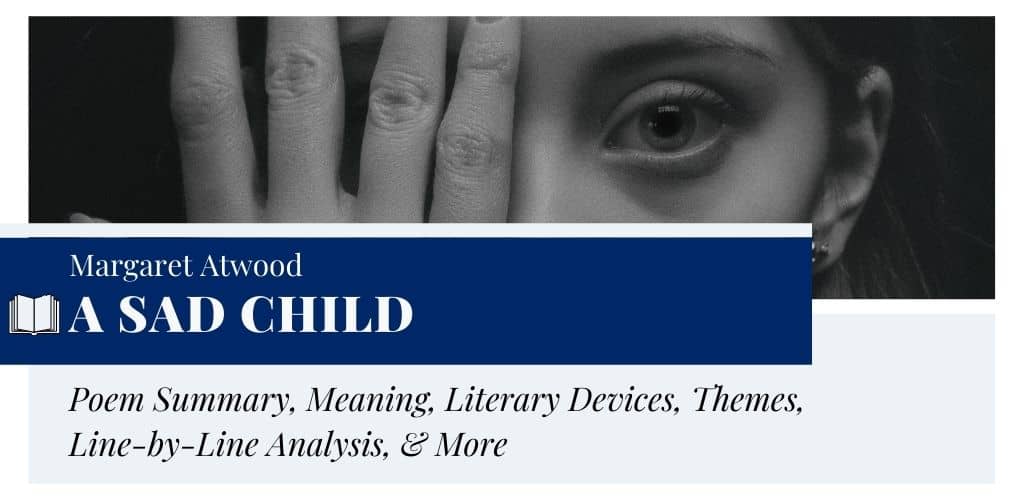A Sad Child by Margaret Atwood
Margaret Atwood’s “A Sad Child” is meant for children who are suffering from sadness and depression. This piece describes how sadness encapsulates a child’s mind and makes her senses weary. It makes them forget about the happy moments of their lives and makes them submit to the bleak darkness of their minds. Atwood tries to help them by saying that grief is an emotion that they have to explore. It helps them to be stronger from the inside. However, the poem ends with an ironic note on the fact that we are all sad in one way or the other.
- Read the full text of “A Sad Child” below:
A Sad Child by Margaret Atwood You're sad because you're sad. It's psychic. It's the age. It's chemical. Go see a shrink or take a pill, or hug your sadness like an eyeless doll you need to sleep. Well, all children are sad but some get over it. Count your blessings. Better than that, buy a hat. Buy a coat or pet. Take up dancing to forget. Forget what? Your sadness, your shadow, whatever it was that was done to you the day of the lawn party when you came inside flushed with the sun, your mouth sulky with sugar, in your new dress with the ribbon and the ice-cream smear, and said to yourself in the bathroom, I am not the favorite child. My darling, when it comes right down to it and the light fails and the fog rolls in and you're trapped in your overturned body under a blanket or burning car, and the red flame is seeping out of you and igniting the tarmac beside your head or else the floor, or else the pillow, none of us is; or else we all are.

Summary
“A Sad Child” is addressed to a child who is feeling low due to some unfortunate events of her life. Atwood describes to her the nature of this mental tension by referring to it as a “chemical” change or a manifestation of age. She needs to get help from a psychiatrist or take a pill. Besides, she can also get some new things in order to forget about her sadness. But, the poet asks what she should forget. Is it the emotion itself or the indignation faced in a lawn party? The way she was treated by others is the source of her grief.
In the following lines, the speaker describes how it feels when a child is ashamed or not accepted among others. Then fog rolls down her senses, the light fails, and agony creeps right into her heart. It feels as if her anger is taking the shape of flames and burning everything around her. At last, Atwood tells her not to think that she is only sad. In modern times, people are also sad in one way or the other.
Meaning
The title of the poem “A Sad Child” makes us think that it is a fairy-tale-like poem about an infant. But, it does not tap on such a theme. Rather, the text shows us a problem of children in the modern age. The fear of getting accepted in the mainstream or the shame of not being too smart, make children feel encapsulated. In this poem, Atwood explores why children become sad. She presents us with a number of probable reasons for their sadness. Besides, she also points out a number of way outs that one can choose to get rid of grief. However, deep down the text, there is a sense of hopelessness. The poet knows no matter what she tells readers, they are going to be sad. It sometimes feels confusing concerning the right way to alleviate their pain.
Structure & Form
Atwood’s “A Sad Child” is a free-verse poem. It does not have a regular rhyme scheme or meter. The text consists of five stanzas. Each stanza contains five lines except the third stanza. The first three stanzas are concluded with end-stopped lines. These stanzas present complete ideas. The last two stanzas are connected internally.
This piece is written from a second-person point of view. Atwood directly addresses readers with the pronoun “You”. She uses a conversational scheme in order to present her thoughts to readers. Regarding the sound scheme, the text contains a number of internal rhymings that make the lines sound rhythmical.
Literary Devices
Atwood used the following literary devices in her poem “A Sad Child”.
- Repetition: The poem begins with a repetition: “You’re sad because you’re sad”. It is used for the sake of emphasis. The first line is followed by another sort of repetition: “It’s psychic. It’s the age. It’s chemical.” Readers can also find the use of this device in some other instances.
- Anaphora: It occurs in “It’s psychic. It’s the age. It’s chemical.” This device is also used in the first two lines of the last stanza. Both these lines begin with the word “and”.
- Simile: The line “or hug your sadness like an eyeless doll”. Here, the comparison is made between “sadness” and “an eyeless doll”.
- Irony: This device is used in the lines “Better than that,/ buy a hat. Buy a coat or pet./ Take up dancing to forget.”
- Rhetorical Question: The first line of the third stanza contains an interrogation.
- Alliteration: It occurs in “see a shrink”, “blessings. Better”, “sulky with sugar”, “blanket or burning”, etc.
- Metaphor: The line “and the red flame is seeping out of you” contains a metaphor. Here, “anger” is implicitly compared to “the red flame”.
- Epigram: The poem ends with an epigram: “none of us is;/ or else we all are.”
Themes
“A Sad Child” taps on the themes of sadness, depression, childhood, and indignation. Atwood talks about the nature of sadness and provides some solutions to get rid of it. According to her, some children can get over it easily while others cannot. Those who cannot opt for some refreshments in order to unburden their minds. Apart from that, the poet also describes how it feels to be depressed. She vividly portrays it by using imagery and metaphors. The theme of indignation and shame is utilized in the third stanza. Summing up the overall subject matter, this piece evokes the universal nature of this bleak emotion that is not limited to only children.
Line-by-Line Analysis & Explanation
Lines 1-5
You’re sad because you’re sad.
It’s psychic. It’s the age. It’s chemical.
Go see a shrink or take a pill,
or hug your sadness like an eyeless doll
you need to sleep.
The first stanza of “A Sad Child” begins with an ironic remark. According to Atwood, one is sad because one is sad. This roundabout reference points out the straightforward nature of one’s sadness. If there is no happiness, one becomes sad. There are some other reasons to be unhappy as well.
This piece is not about the sadness of adults. So, Atwood’s speaker directly addresses children who are feeling low. She advises them to be aware of this emotional turmoil as it is psychic, related to one’s psyche. Sometimes, it originates during the transition of infancy to puberty. Grief is a chemical reaction constantly happening in one’s mind.
By providing the clinical definition of monotony, Atwood gives parental advice to the readers by telling them to see a psychiatrist or take anti-depressant pills. If her target audience is children, the advice seems to be a bit rash. However, in the modern age, these solutions are handy to pick up.
In the last two lines, she uses a smile in order to describe the nature of sadness. It is like an eyeless doll, unable to close its eyes while laying down. When a child is sad, she feels the same as the lidless doll.
Lines 6-10
Well, all children are sad
but some get over it.
Count your blessings. Better than that,
buy a hat. Buy a coat or pet.
Take up dancing to forget.
The second stanza begins with an epigraph. Atwood’s speaker tells readers that some of them can get over their sadness easily. While others cannot. It depends on their mental strength or ability to cope up with challenges. In general, children are not born with this ability. They acquire it through time. Those who are weak can count on the blessings.
This solution does not seem workable. Hence, the speaker says that it is better to divert their attention to something else, rather than sitting alone, covered with the gloom of sadness. They can buy things such as a hat, coat, or a pet that can cheer them up. The term “pet” used beside the inanimate objects creates an anticlimax. It is used for the ironic effect.
The last solution is to take up dancing. Like any other art, it can help them to come out of depressing thoughts.
Lines 11-20
Forget what?
Your sadness, your shadow,
whatever it was that was done to you
the day of the lawn party
when you came inside flushed with the sun,
your mouth sulky with sugar,
in your new dress with the ribbon
and the ice-cream smear,
and said to yourself in the bathroom,
I am not the favorite child.
The third stanza is the longest one among the other stanzas. It consists of ten lines that are not separated into two five-line stanzas. This section opens with a rhetorical question. Here, the speaker asks about what to forget. Is it the discouraging thoughts or the memories fuelling their agony and anger?
The poet provides the answer herself. It can be their sadness or the “shadow” of the past. Besides, it can be the harsh incidents that occurred in their lives. The wrongs they have endured and the taunts they digested, cannot be forgotten.
In the following lines, she talks about a probable scenario where a child feels ashamed. She assumes a lawn party where a child came after getting flushed with the sun. Her mouth is sulking with the taste of sugar and her new dress is smeared with ice cream.
After returning from the party, she might have locked herself into the bathroom and repeatedly told herself that she might not be the favorite child. This feeling of being alienated or castigated from the mainstream is always there in a child’s mind. It contributes to their sadness as well.
Lines 21-25
My darling, when it comes
right down to it
and the light fails and the fog rolls in
and you’re trapped in your overturned body
under a blanket or burning car,
The fourth stanza of “A Sad Child” begins with a cajoling remark of Atwood. She adorably addresses the child and tells her how sadness feels like. When one comes right down to this phase, the light vanishes. Darkness starts to reign. The fog of despair rolls in and one feels trapped inside the body. Her soul feels tortured and it feels suffocating while breathing.
She might be in her bed, overturned under a blanket and thinking of what happened to her. Besides, she can also inside a metaphorical “burning car”. It is a reference to her “mind” that is compared to a vehicle. The car seems to be burning due to anger and agony.
Lines 26-30
and the red flame is seeping out of you
and igniting the tarmac beside you head
or else the floor, or else the pillow,
none of us is;
or else we all are.
Atwood continues the thoughts in this stanza. She enjambs the first line of this section with the previous one. The first two lines contain an anaphora. These lines begin with the word “and” which is used to create a connection between the lines.
Here, the speaker describes how one’s anger, like a “red flame”, seeps out of the mind. It ignited the tarmac beside the child. Then, the heat transfers to other things around her like her head, the floor, or the pillow.
The last two lines are not connected to the idea of the previous lines. Here, Atwood describes how none of us is sad apparently. In reality, we all are sad in one way or another. The difference lies in the cause of our sadness. In this way, Atwood tells us of a vital problem of the modern age among humans. It is the absence of true happiness, a sense of security, and satisfaction.
Historical Context
“A Sad Child” is a modern poem about the theme of sadness and depression. This piece points out a few probable causes of a child’s sadness and defines the emotion. The poet Margaret Atwood wrote eight books for children and 18 books of poetry. She began writing in the 1960s when postmodernism was at its height. “A Sad Child” probably appears in her poetry collection Talismans for Children, published in 1965. In this poem, Atwood implies that not only children but also adults of the modern age are all sad deep inside.
Questions and Answers
Margaret Atwood’s poem “A Sad Child” is a poetic address to children who are sad or feeling discouraged about some unfortunate events. The poet tells them it’s okay to be sad as in modern times we all are sad. The only difference is some of us show it openly while some keep it buried inside their minds.
“A Sad Chid” free-verse lyric poem that is written in a conversational style. This piece is addressed directly to readers. Besides, it consists of five stanzas each having five lines except the third stanza. For more details refer to the Structure & Form section.
The first line of the poem contains a repetition of the phrase “You’re sad”. Atwood uses this repetition in order to emphasize her point that one is sad because of the mind. If we don’t have emotions, we don’t feel sad anymore.
The child in the poem is sad because of the embarrassment at a lawn party. She went there to have fun. However, things didn’t go well. Hence, she returned to her home sadly with the feeling of being alienated.
This piece explores the themes of sadness, mind, shame, and depression. Atwood describes why one feels sad and how to get over it if it is possible.
In this line, Atwood uses a simile in order to compare two distinct ideas “sadness” and “an eyeless doll”.
Similar Poems about Sadness
- “Death of a Young Son by Drowning” by Margaret Atwood — This piece is about a sad tale about a child’s death by drowning.
- “When I Was Fair and Young” by Queen Elizabeth I — In this poem, the speaker laments the loss of her youth and the unfortunate turn of her fate.
- “The Toys” by Coventry Patmore — This poem presents us with a heartwarming story of a father and son.
- “On Another’s Sorrow” by William Blake — In this piece, Blake tells readers not to be sad as God is always there to help us get over our problems.
- “The Nightingale” by Sir Philip Sidney — This poem presents a heartbroken speaker who feels sad after listening to the song of the nightingale.
External Resources
- Check out Dearly: New Poems — Explore this 2020 poetry collection of Margaret Atwood and dive into the poems published in this collection.
- Biography of Margaret Atwood — Learn about the poet’s biography.
- About Margaret Atwood — Read more about the poet’s life and her poetic works.
- Poet Profile & Poems of Margaret Atwood — Explore the poet’s profile and read some of her best-known poems.





